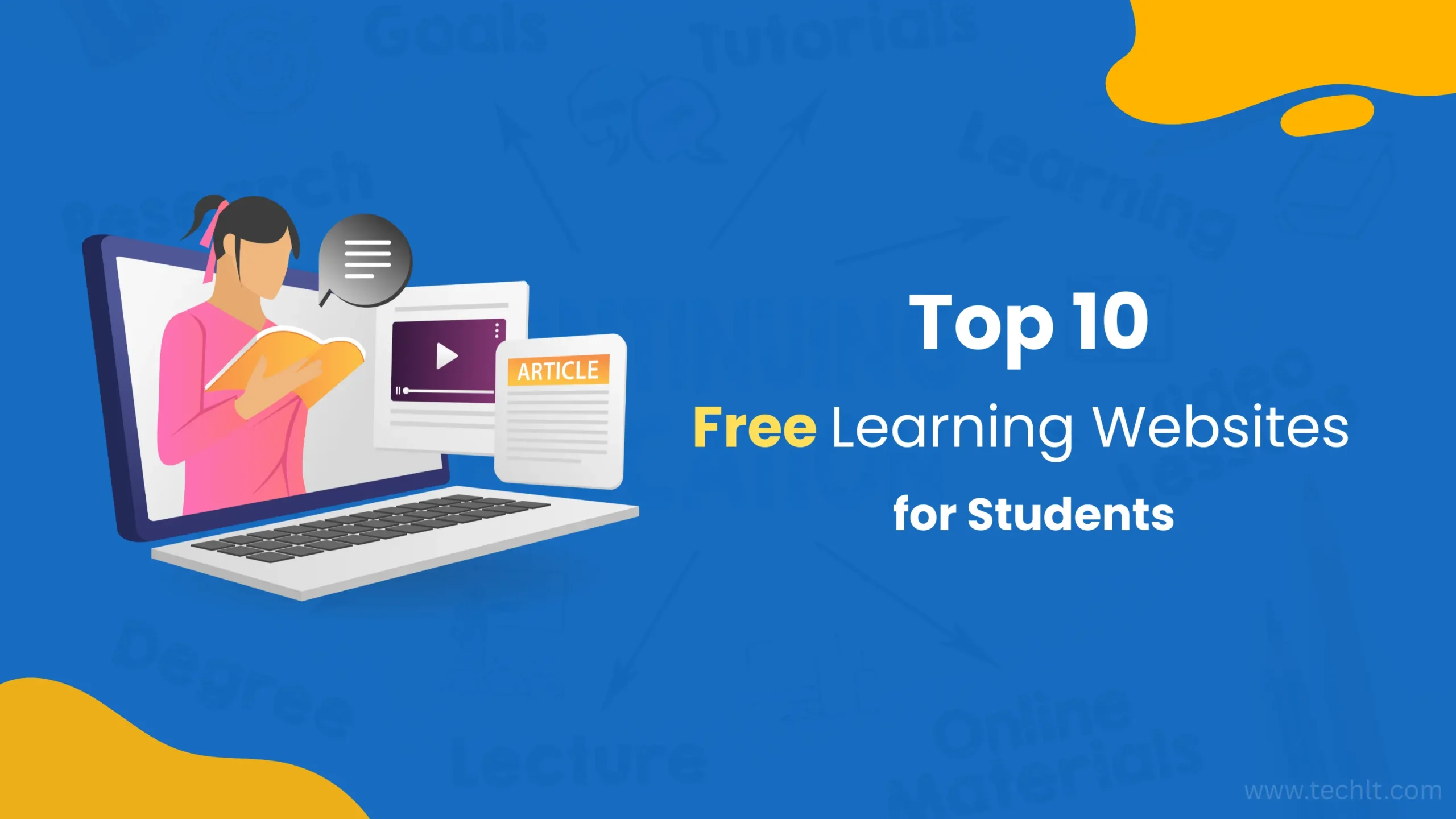Lifestyle
Best Free Learning Websites for Students

Have you ever dreamed of having access to an entire class available 24/7 without paying any fees? Well, that wish is closer than you think. In today’s digital world, there are many free learning websites for students that make studying easier, more flexible, and even fun. Whether you’re stuck on a difficult math concept, want to explore a new topic, or just want to revise for an exam, a useful free online resource can save you time, money, and stress.
Why are free learning websites for Students important? First, they break down barriers: no expensive textbooks, no expensive tuition, and often you can study at your own pace—which is important when you have other things going on (homework, school projects, maybe even a part-time job). In addition, they also provide you with options. If you don’t understand something in class, you can go back, summarize, practice, and repeat. In short: you gain control over your learning.
- The Top 10 Free Learning Websites for Students
- How to Choose the Right Free Learning Websites for students
In this article, we look at the 10 best Free Learning websites for students (that you can bookmark right now!)—platforms that offer high-quality content, easy access, and genuinely student-friendly features. Then we’ll help you figure out how to choose the right free learning websites for your style and needs. Please consider bookmarking this list and revisiting it when you’re ready to explore something new.
The Top 10 Free Learning Websites for Students

Here are 10 strong choices. For each one I’ll describe what it is, why it’s worth using, some standout features (and one small downside so you get the full picture), and a quick “Best for…” summary to help you pick the right one for you.
1. Khan Academy (khanacademy.org)
Overview:
Khan Academy is a nonprofit organization that provides entirely free lessons and practice across subjects—math, science, history, grammar, and even life skills. It offers videos, articles, and interactive practice and has versions aligned to the Indian curriculum (in several languages) as well.
Why it’s good for students:
If you’re a student struggling with something like algebra or want to build foundation skills (say in math or science), Khan Academy is perfect. You can go at your own pace, rewind videos, practice problems again and again, and track your progress. Because it is free and high-quality, it breaks the “I can’t afford extra tuition” barrier. The interface is friendly and non-intimidating. It also supports mobile use, which is helpful if you prefer your phone/tablet to a computer.
Stand-out features:
- Huge catalog of topics from primary school up to advanced high school level.
- Adaptive practice—if you make mistakes, you can revisit topics.
- Multi-language support (for India, among others), which means better accessibility.
- No cost, no tricky login forms, accessible for everyone.
Downside:
Because it’s so broad, if you want ultra-advanced specialised topics (say niche university-level engineering topics) you might have to look elsewhere. Also, certificates are limited.
Best for:
Students who need a reliable, free place to build or strengthen foundational skills (especially in maths/science) and prefer self-paced learning.
2. edX (edx.org)
Overview:
edX is a major platform co-founded by Harvard and MIT offering massive open online courses (MOOCs). You can audit courses (view content for free) and pay only if you want a verified certificate.
Why it’s good for students:
If you’ve finished your school syllabus and want to explore something beyond—say computer science, business, AI, or economics—edX gives you access to courses from world-renowned institutions. Because you can audit for free, you can study without paying. That means quality learning for zero cost. Also, the flexibility means you can learn when you want.
Stand-out features:
- Access to top university-level content (Harvard, MIT, etc.).
- Huge variety of topics—from humanities to STEM.
- Self-paced or scheduled courses depending on the topic.
- Free auditing track means you get the content, even if you skip the paid certificate.
Downside:
A free audit usually means you don’t get the certificate unless you pay. Also, some courses are advanced and assume prior knowledge, so if you’re brand-new, you may find them challenging.
Best for:
Students who are comfortable with independent learning, want to explore university-level topics, or aim to build skills beyond the school syllabus.
3. Codecademy (codecademy.com)
Overview:
Codecademy offers interactive coding classes—many for free—in languages like Python, JavaScript, HTML/CSS, and more.
Why it’s good for students:
If you’ve ever thought “I want to build websites or apps” or simply “I want to try coding but don’t know where to start”, this is an excellent free online resource. Instead of just watching videos, you actually write code in the browser and see results—this hands-on approach helps learning stick.
Stand-out features:
- Free beginner-friendly courses that let you start coding immediately.
- Real browser-based interactive editor: you code as you learn.
- Clear path through different languages and topics.
Downside:
Many of the more advanced or project-based courses require a paid “Pro” subscription. Also, free courses may cover only basics—not deep computer science theory.
Best for:
Students who want to dive into programming/coding, especially beginners wanting to try it out for free.
4. GCFGlobal (edu.gcfglobal.org)
Overview:
GCFGlobal offers free self-paced tutorials in technology (e.g., Microsoft Office), math, reading, everyday life skills, and more. It’s a nonprofit initiative.
Why it’s good for students:
If you want to improve practical skills (like using Word/Excel, basic math, reading comprehension, and digital literacy), then this site is very helpful. It helps build “life-ready” skills, which many students don’t explicitly get in school. Also, the fact that it’s self-paced and free means you can fit it around your schedule.
Stand-out features:
- No registration required for many tutorials (easy access).
- Both video and text tutorials, with practice exercises.
- Coverage of everyday digital skills, which are extremely useful for schooling and beyond.
Downside:
It isn’t as flashy as some big MOOC platforms; content is more practical/skills-based rather than deep academic topics. Also the design/interface is a bit simple.
Best for:
Students who need to build digital or everyday skills (office tools, reading, basic math) and want a no-cost flexible option.
5. Coursera (coursera.org)
Overview:
Coursera is another large MOOC provider offering free courses (audit mode) plus paid certificate tracks. For example, you can access course videos and reading materials for free in numerous instances.
Why it’s good for students:
If you’re studying at a higher level or are preparing for a future career, Coursera offers real-world-relevant courses from companies and universities. The free audit mode means you can still access high-quality content without paying. This helps widen your learning options.
Stand-out features:
- Courses from industry partners and universities (so content relevance is good).
- Free option available (you just pay for the certificate).
- Wide topic range: business, tech, arts, social sciences.
Downside:
Free access may omit some features (like graded assignments or certificates). You may need to pay if you want full access or credentials. Also, course duration can be long and require commitment.
Best for:
Students who are ready for structured courses, maybe aiming at career or university preparation, and willing to invest time (free access, but you still need to commit).
6. SOPHIA Learning (sophia.org)
Overview:
SOPHIA Learning offers free tutorials and, in some cases, low-cost courses for credit. It started with many free resources created by teachers and scholars.
Why it’s good for students:
If you’re trying to catch up in a subject or want flexible lessons on a topic you missed, SOPHIA can help. Its tutorial-style format is straightforward. Because it is free for many parts, it’s accessible.
Stand-out features:
- Teacher-created tutorials, free to access.
- Good for self-paced learning and revision.
- Covers multiple subject areas.
Downside:
Some credit-bearing courses or intensive content may have a cost; The free section may be more limited than large MOOC sites. Additionally, the user interface may feel less sophisticated.
Best for:
Students who need extra help in a subject, want tutorials to catch up or review, and prefer simple, direct learning resources.
7. Open Learn via Open University (open.edu)
Overview:
(Open Learn is a platform of The Open University and offers a broad range of free short courses and articles across subjects (arts, business, science, and health).)
(Note: though not deeply cited above, Open Learn is widely known in educational circles as a free learning websites for students and adult learners.)
Why it’s good for students:
If you enjoy learning outside the standard school syllabus—exploring new topics like philosophy, environment, or psychology—this site gives you free access. Many courses are short (2-6 hours), so you can dip in easily.
Stand-out features:
- Free level-beginner-friendly courses.
- Many interesting subjects beyond just “school topics.”
- You have the flexibility to learn at your own pace.
Downside:
Certificates (if any) may require payment; some courses are more like “mini-modules” rather than full deep courses. Also may emphasise adult learners rather than teenagers.
Best for:
Students who want to explore interesting “extra” topics, broaden their learning, and enjoy self-directed study.
8. FutureLearn (futurelearn.com)
Overview:
FutureLearn is another platform offering free versions of courses from universities and cultural institutions. You can join free for the “access period” and learn, then optionally pay for a certificate or extended access.
Why it’s good for students:
It gives a wide variety of courses—history, film studies, creative writing, science—so if you’re a student looking beyond your school syllabus or want to pick up new interests, this is a strong choice. The social/discussion element helps you connect with other learners.
Stand-out features:
- Courses from university/culture partners (good content quality).
- Free access track available.
- Engaging discussion forums to interact with peers.
Downside:
Free access is time-limited (you may have access for a few weeks only unless you upgrade); certificates cost extra. Sometimes you need to schedule weekly activities (less purely self-paced).
Best for:
Students who are curious about new subjects, like social learning/discussion, and want a free option to experiment with online university-style learning.
9. TED‑Ed (ed.ted.com)
Overview:
TED-Ed offers short and interesting animated videos on many subjects, like science, literature, psychology, and art. Each lesson is fun to watch and often comes with a small quiz to test what you’ve learned.
Why it’s great for students:
If you’ve got just 10–15 minutes and want to learn something new, TED-Ed is a fantastic choice. The colorful animations and simple explanations make even tough topics easy to understand. It’s perfect for students who learn better by watching videos—and the best part is, it’s completely free!
Stand-out features:
- Engaging video-based lessons (not long lectures).
- Covers unusual or interdisciplinary topics (e.g., how memory works, the science of color).
- Free, no huge time commitment required.
Downside:
Because the lessons are short and varied, it is less structured for deep subject mastery. If you want systematic learning (e.g., a full course in physics), you’ll probably need something more.
Best for:
Students who enjoy short, interesting learning sessions, want to supplement their regular study with curiosity or inspiration, or prefer video/animation-style learning.
10. AcademicEarth (academicearth.org)
Overview:
AcademicEarth collects free online lectures and courses from leading universities across many subjects. Its mission is to provide “free video lectures from top colleges.”
Why it’s good for students:
If you favor video lectures and want to watch university-level content (e.g., around economics, philosophy, and science) for free, this site gives you access. For students who like to ‘watch and learn’ rather than just read or do practice, this is useful.
Stand-out features:
- Free video lectures from university faculty at top schools.
- Wide subject range, especially humanities/sciences.
- Free access to high-quality content.
Downside:
Often just video lectures (less interactive practice); no personalized dashboards or quizzes in many cases. Also, navigation may be less user-friendly.
Best for:
Students who prefer watching videos, exploring advanced lectures for free, or looking for inspiring content beyond regular school topics.
(Note: Some of these platforms overlap in functionality—feel free to try more than one to see what style fits you best.)
How to Choose the Right Free Learning Websites for students
Now that you have the list of ten excellent free learning websites for students, the next question is, which one should you pick? Here are some helpful tips to guide your selection so you don’t just scatter across a dozen sites but pick one that helps you learn effectively.
- Think about your learning style
- Consider your subject needs
- Check for certificate / credential if you care
- Time commitment & flexibility
- Language and accessibility
- Cost / hidden costs
- Match it to your goal
Conclusion
Free learning websites are like treasure chests for students, packed with opportunities to grow and explore. Whether you’re looking to sharpen your math and science skills, dive into a new hobby, or even gear up for your dream career, there’s something out there for everyone. The trick? Find a platform (or two) that fits your vibe, stick with it, and make it part of your daily routine.
But here’s the thing: just having access to great content isn’t enough. Real learning happens when you put in the effort—set aside time, practice regularly, and actually use what you’ve learned. Solve problems, chat about it with friends, or even teach someone else (trust me, teaching is a game-changer for understanding).
So, why not start small? Pick one platform—maybe Khan Academy if you need help with school subjects, or edX if you’re curious about something new—and commit to just 30 minutes a day for two weeks. After that, check in with yourself: Is it working? Are you enjoying it? If yes, keep going. If not, no worries—try another one from the list.
You’ve got everything you need to start learning. Now it’s up to you to make it happen. Bookmark this list of the top 10 free learning websites, pick your first one, and dive in. Your future self will be so proud.
Happy learning!
free learning websites for students, best study websites for students, free online learning platforms, online education for students, top learning websites 2025, free study sites for students, online courses for students free
-

 Technology6 months ago
Technology6 months agoHow to Spot Fake News Online: 10 Simple Tips to Stay Safe
-

 Automobile6 months ago
Automobile6 months ago5 Best Bikes Owned by Bollywood Stars
-

 News6 months ago
News6 months agoNirmal Kapoor, Anil Kapoor’s Mother, Passes Away at 90
-

 Lifestyle5 months ago
Lifestyle5 months agoMedha Shankar Age, Movies, and TV Shows – Full Biography of a Rising Star
-

 Technology5 months ago
Technology5 months agoBest Free Apps You Should Try
-

 Technology6 months ago
Technology6 months ago7 Industries Benefiting from Deep Learning Algorithms
-

 Technology1 month ago
Technology1 month agoWhat is Metaverse? Simple Explanation for Beginners
-

 Technology1 week ago
Technology1 week agoHow to Use Google Pay Safely in India – Complete Beginner’s Guide

